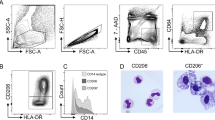Abstract
The phenotypes and ultrastructure of macrophages and dendritic cells in aphthoid lesions of the colon were immunocytochemically observed in patients with Crohn's disease. Biopsy specimens were endoscopically obtained from both aphthoid and advanced lesions in Crohn's disease patients. Biopsy specimens obtained from patients with infectious colitis and from normal individuals served as controls. Aphthoid lesions contained densely aggregated CD68+ macrophages, which were surrounded by numerous ID-1+ dendritic cells. In the normal controls and infectious colitis patients, however, a few scattered CD68+ macrophages and ID-1+ dendritic cells were noted beneath the surface epithelium. CD3+ lymphocytes were significantly increased in both aphthoid and advanced lesions of Crohn's disease, but the CD4/CD8 ratio was similar in all groups studied. The double immunoperoxidase staining method revealed that both CD68+ macrophages and ID-1+ dendritic cells in the aphthoid lesions simultaneously expressed ICAM-1 and HLA-DR antigens. Electronmicroscopic observation revealed that CD68+ macrophages had numerous vesicles and lysosomal granules and few projections, and that ID-1+ dendritic cells had appreciable cytoplasmic protrusions with a few vacuoles. These findings suggested that the colonic mucosa in Crohn's disease contained two types of macrophage/dendritic cells in the same lineage that expressed intercellular adhesion molecules and class-II MHC antigens. It also appeared that the aphthoid lesions of Crohn's disease featured an increase in macrophages and dendritic cells consistent with immunological activation.
Similar content being viewed by others
References
Nagura H. Mucosal defense mechanism in health and disease. Acta Pathol Jpn 1992;42:87–400.
Matsuura T, West GA, Youngman KR, et al. Immune activation genes in inflammatory bowel disease. Gastroenterology 1993;104:448–458.
Selby WS, Janossy G, Bofill M, et al. Intestinal lymphocyte subpopulations in inflammatory bowel disease: An analysis by immunohistological and cell isolation techniques. Gut 1984;23: 32–40.
James SP, Fiocchi C, Graeff AS, et al. Phenotypic analysis of lamina propria lymphocytes. Predominance of helper-inducer and cytolytic T-cell phenotypes in Crohn's disease and control patients. Gastroenterology 1986;91:1483–1489.
Allison MC, Poulter LW, Dhillon AP, et al. Immunohistological studies of surface antigen on colonic lymphoid cells in normal and inflamed mucosa. Gastroenterology 1990;99:421–430.
Seldenrijk CA, Drexhage HA, Meuwissen SGM, et al. Dendritic cells and scavenger macrophages in chronic inflammatory bowel disease. Gut 1989;30:484–491.
Nakamura S, Ohtani H, Watanabe Y, et al. In situ expression of cell adhesion molecules in inflammatory bowel disease: Evidence of immunologic activation of vascular endothelial cells. Lab Invest 1993;69:77–85.
Altmann DM, Hogg N, Trowsdale J, et al. Cotransfection of ICAM-1 and HLA-DR reconstitutes human antigen-presenting cell function in mouse L cells. Nature 1989;338:512–514.
Okada M, Maeda K, Yao T, et al. Minute lesions of the rectum and sigmoid colon in patients with Crohn's disease. Gastrointest Endosc 1991;37:319–324.
Sankey EA, Dhillon AP, Anthony A, et al. Early mucosal changes in Crohn's disease. Gut 1993;34:375–381.
The Japanese Research Committee for Crohn's disease: Crohn's disease in Japan. Gastroenterol Jpn 1979;14:366–373.
Pulford KAF, Rigney EM, Micklem KJ, et al. KP1: A new monoclonal antibody that detects a monocyte/macrophage associated antigen in routinely processed tissue sections. J Clin Pathol 1989;42:414–421.
Nakamura S, Suchi T, Suzuki R. Interdigitating cell sarcoma (ICS). Evidence of interdigitating cell origin, immunocytochemical studies with monoclonal anti-ICS antibodies. Virchows Arch [A] 1989;415:447–457.
Makiyama K, Bennett MK, Jewell DP. Endoscopic appearance of the rectal mucosa of patients with Crohn's disease visualized with a magnifying colonoscope. Gut 1984;25:337–340.
Xin YN, Goldberg HI. Aphthoid ulcers in Crohn's disease: Radiographic course and relationship to bowel appearance. Radiology 1986;158:589–596.
Malizia G, Calabrese A, Cottone M, et al. Expression of leucocyte adhesion molecules by mucosal mononuclear phagocytes in inflammatory bowel disease. Gastroenterology 1991;100: 150–159.
Patarroyo M, Prieto J, Rincoln J, et al. Leukocyte-cell adhesion: A mononuclear process fundamental in leucocyte physiology. Immunol Rev 1990;114:67–108.
Dougherty GJ, Murdoch S, Hogg N. The function of human intercellular adhesion molecule-1 (ICAM-1) in the generation of an immune response. Eur J Immunol 1988;18:35–39.
Adams DO, Hamilton TA. Molecular transductional mechanisms by which IFN-r and other signals regulate macrophage development. Immunol Rev 1987;97:5–27.
Matsuura T, Fiocchi C. Cytokine production in the gastrointestinal tract during inflammation. In: Walker A, Harmatz PR, Wershil BK (eds) Immunophysiology of the gut. New York: Academic, 1993;145–163.
Lowes JR, Radwan P, Priddle JD, et al. Characterization and quantification of mucosal cytokine that induces epithelial histocompatibility locus antigen-DR expression in inflammatory bowel disease. Gut 1992;33:315–319.
Machida YR, Sarla P, Wu K, et al. Interleukin-2 receptor expression by macrophages in inflammatory bowel disease. Clin Exp Immunol 1988;74:382–386.
Collings LA, Waters MFR, Poulter LW. The involvement of dendritic cells in the cutaneous lesions associated with tuberculoid and lepromatous leprosy. Clin Exp Immunol 1985;62:458–467.
Author information
Authors and Affiliations
Rights and permissions
About this article
Cite this article
Morise, K., Yamaguchi, T., Kuroiwa, A. et al. Expression of adhesion molecules and HLA-DR by macrophages and dendritic cells in aphthoid lesions of Crohn's disease: An immunocytochemical study. J Gastroenterol 29, 257–264 (1994). https://doi.org/10.1007/BF02358363
Received:
Accepted:
Issue Date:
DOI: https://doi.org/10.1007/BF02358363




